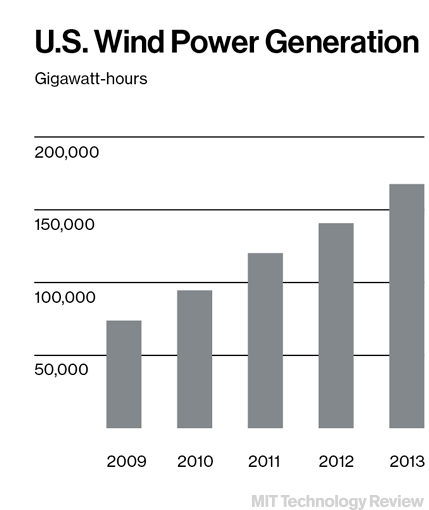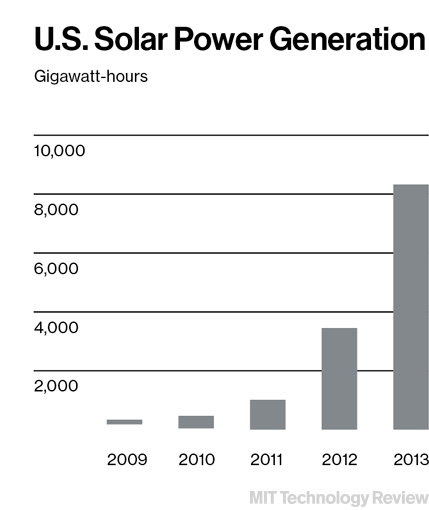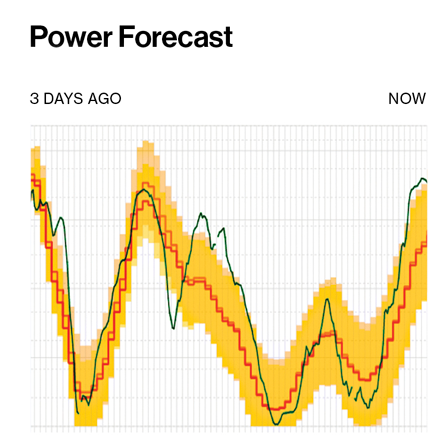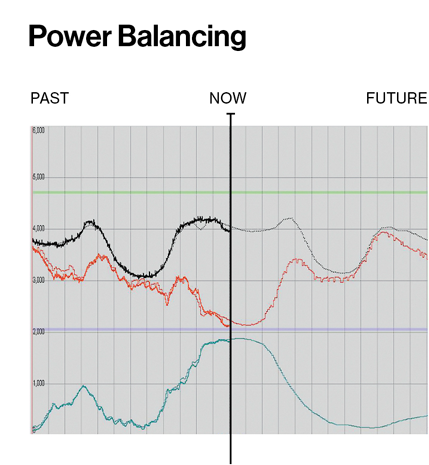Smart Wind and Solar Power
Apr 28 2014 - Kevin Bullis - technologyreview.com
Big data and artificial intelligence are producing ultra-accurate forecasts that will make it feasible to integrate much more renewable energy into the grid.
Wind power is booming on the open plains of eastern Colorado. Travel seven miles north of the town of Limon on Highway 71 and then head east on County Road 3p, a swath of dusty gravel running alongside new power lines: within minutes you'll be surrounded by towering wind turbines in rows stretching for miles. Three large wind farms have been built in the area since 2011. A new one is going up this year.
Every few seconds, almost every one of the hundreds of turbines records the wind speed and its own power output. Every five minutes they dispatch data to high-performance computers 100 miles away at the National Center for Atmospheric Research (NCAR) in Boulder. There artificial-intelligence-based software crunches the numbers, along with data from weather satellites, weather stations, and other wind farms in the state. The result: wind power forecasts of unprecedented accuracy that are making it possible for Colorado to use far more renewable energy, at lower cost, than utilities ever thought possible.

The amount of wind power has more than doubled since 2009.
The forecasts are helping power companies deal with one of the biggest challenges of wind power: its intermittency. Using small amounts of wind power is no problem for utilities. They are accustomed to dealing with variability-after all, demand for electricity changes from season to season, even from minute to minute. However, a utility that wants to use a lot of wind power needs backup power to protect against a sudden loss of wind. These backup plants, which typically burn fossil fuels, are expensive and dirty. But with more accurate forecasts, utilities can cut the amount of power that needs to be held in reserve, minimizing their role.
Before the forecasts were developed, Xcel Energy, which supplies much of Colorado's power, ran ads opposing a proposal that it use renewable sources for a modest 10 percent of its power. It mailed flyers to its customers claiming that such a mandate would increase electricity costs by as much as $1.5 billion over 20 years.
But thanks in large part to the improved forecasts, Xcel, one of the country's largest utilities, has made an about-face.
It has installed more wind power than any other U.S. utility and supports a mandate for utilities to get 30 percent of their energy from renewable sources, saying it can easily handle much more than that.

Solar power generation lags wind power production by about a decade.
An early version of NCAR's forecasting system was released in 2009, but last year was a breakthrough year-accuracy improved significantly, and the forecasts saved Xcel nearly as much money as they had in the three previous years combined. This year NCAR is testing a similar forecasting system for solar power.
Mining these detailed forecasts to develop a more flexible and efficient electricity system could make it much cheaper to hit ambitious international goals for reducing carbon emissions, says Bryan Hannegan, director of a $135 million facility at the National Renewable Energy Laboratory (NREL) in Golden, Colorado, that uses supercomputer simulations to develop ways to scale up renewable power. âWe've got a line of sight to where we want to go in the long term with our energy and environment goals,â he says. âThat's not something we've been able to say before.â
Chasing the Wind
No one is more aware of the challenges of integrating wind power into the grid than Dayton Jones, a power plant dispatcher for Xcel Energy. From his perch on the 10th floor of the Xcel building in downtown Denver, he's responsible for keeping the lights on in Colorado. Doing so requires matching power production to electricity demand by turning power plants on and off and controlling their output. Generating too much or too little power can damage electrical appliances or even plunge the grid into a blackout. Wind power, with its sharp fluctuations, makes his job harder.
Running backup fossil-fuel plants means âthrowing carbon up into the skyâ: âIt costs money, and it's bad for the environment.â
A few years ago, dispatchers like Jones couldn't trust forecasts of how much wind power would be available to the grid at a given time. Those forecasts were typically off by 20 percent, and sometimes wind power completely failed to materialize when predicted. The solution was to have fossil-fuel plants idling, ready to replace all of that wind power in a few minutes. This approach is expensive, and the more the system is intended to rely on wind power, the more expensive it gets. What's more, running the backup fossil-fuel plants means you're âthrowing carbon up into the sky,â says William Mahoney, deputy director of the Research Applications Laboratory at NCAR. âIt costs money, and it's bad for the environment.â

Actual power output (green line) is overlaid on a three-day wind power forecast (red line). The larger the yellow shaded area, the more uncertain the forecast.
NCAR's forecasts give Jones enough confidence in wind power to shut down many of the idling backup plants. The number varies depending on the certainty of the forecast. If the weather is cold and wet and there's a chance ice could form on wind turbines and slow them down or stop them from spinning, he might need enough fossil-fuel backup to completely replace his wind power.
But on nice days with steady, abundant wind, he might shut down all his fast-response backup plants, even those normally reserved for responding to changes in demand. Under such circumstances, Jones can use the wind farms themselves to ensure that power supply matches demand: the output of a wind turbine can be changed almost instantly by angling the blades so they capture more or less wind. Computers at Xcel's building in Denver tell wind farms how much power to produce, and automated controls coördinate hundreds of turbines, changing output minute by minute if needed.
Xcel's original forecasts used data from just one or two weather stations per wind farm. Now NCAR collects information from nearly every wind turbine. The data feeds into a high-resolution weather model and is combined with the output from five additional wind forecasts. Using historical data, NCAR's software learns which forecasts are best for each wind farm and assigns different weights to each accordingly. The resulting über-forecast is more accurate than any of the original ones. Then, using data about how much power each turbine in the field will generate in response to different wind speeds, NCAR tells Xcel how much power to expect, in 15-minute increments, for up to seven days.
Forecasting solar power is next for NCAR and Xcel, but that can be even trickier than wind. For one thing, Xcel doesn't get information about how much power private rooftop solar panels are generating, so it doesn't know how much of that power it could lose when clouds roll in. NCAR's new solar forecasts will use data from satellites, sky imagers, pollution monitors, and publicly owned solar panels to infer how much solar power is being generated and then predict how that amount will change.
Virtual Energy
How might extremely accurate wind and solar forecasts help us use enough renewable energy to reach climate goals of significantly reducing carbon dioxide emissions? Researchers at NREL's new Energy Systems Integration Facility start by looking at how well wind and solar power can offset each other. To what extent, for example, can wind blowing at night make up for the lack of sunshine? But they are also looking at how to couple forecasts with smart dishwashers, water heaters, solar-panel inverters, water treatment plants, and electric-car chargers, not only to accommodate shifts in the wind but to ride out inevitable windless periods and weeks of cloudy weather without resorting to fossil fuels.

The red line-the result of subtracting wind power supply (blue) from demand (black)-shows the amount of power Xcel needs to generate with its fossil-fuel plants. The lighter lines are forecasts.
Take the example of electric cars. A car stores enough electricity to power a house for anywhere from half a day to several days, depending on the size of the battery pack. And it has sophisticated power electronics that can control the timing and vary the rate of charging, which could offer a way to match fluctuating wind power to electricity demand. With small modifications, the carsâ batteries can deliver stored power to a home and to the power grid. There aren't many electric cars now, but that could easily change in the decades it will take before renewable energy makes up more than 30 or 40 percent of the electricity supply (wind supplies 4 percent now, and solar less than 1 percent).
At NREL, researchers can plug 30 electric cars into docks that let them interface with power-grid simulations on a supercomputer, to project what would happen if thousands of cars were connected to the grid. The idea is that electric cars might store power from solar panels and use it to power neighborhoods when electricity demand peaks in the evening, and then recharge their batteries using wind power in the early morning hours.
Forecasts like the ones being developed at NCAR will be âabsolutely critical,â says Bri-Mathias Hodge, a senior research engineer at NREL. They will help determine when the cars' batteries should charge to maximize the electricity they make available to the grid without leaving drivers short of the power they need.